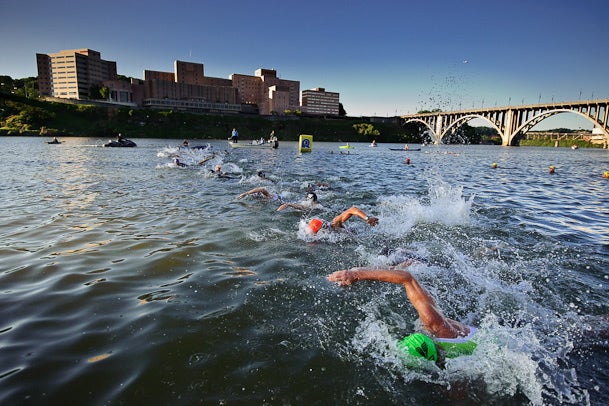Swim Vocabulary Made Simple

Photo: Nils Nilsen
The freestyle swim stroke has several subtle parts that make up the whole. Each swim coach, program or athlete has a different way of explaining each of these small parts. Sometimes it’s confusing when different vocabulary is used to describe one part of the stroke.
Swimming technique, balance, body position and hip rotation are important elements of the freestyle swim stroke. A coach might critique your balance in the water but praise your hip rotation; or she might try to tweak your body position and ignore your balance. It is important to understand what each term means so you can make improvements.
First is balance. Your upper body and your legs should share the effort of moving you through the water. Specifically, your arms should make a 50 percent to 70 percent contribution to your forward propulsion while your legs should account for the remaining 50 percent to 30 percent. Swimmers who drag their legs behind their body, with almost no visible kick, are missing out on the potential core power that is derived from the hips. On the other hand, if your legs are tiring long before your upper body, consider lessening your kick to conserve energy. By swimming with a two- or four-beat beat kick (meaning you complete two or four individual kicks per complete arm stroke cycle), athletes can benefit from the power in their legs without tiring too quickly.
Balance in the water also means having the movement of the stroke come easily and naturally. A swimmer with good balance is not fighting the water; she is efficiently working with the water, gravity and her own body. Both sides of her body are making similar movements. And yes, balanced swimming requires bilateral breathing.
In terms of body position, try to maintain a constant position during the entire stroke cycle. Strive for a horizontal position in the water with your face pointing toward the bottom of the pool and your hips near the surface of the water. You can practice floating with a snorkel or streamline kicking to become comfortable in this position. Your position is good if your feet break the surface of the water with each kick.
RELATED: 3 Ways To Improve Your Swim Posture
Next, try to keep your body position in a straight line. Think about being “skewered” from the top of your head, through your neck and down your spine. You can rotate on this skewer but you cannot move any part of your body laterally. Drag and resistance are minimized with a streamlined position.
Finally, there is the fine art of hip rotation, which actually refers to shoulder, torso and hip rotation. To understand rotation correctly, you must first recognize “disconnect.” Rotation occurs from the middle of the neck to the middle of the thigh. The head and legs are disconnected from the rotation. When the hips, torso and shoulders are maximally rotated 45 degrees to the left or right in the water, your head and legs should maintain a horizontal position. This allows your kick to keep a steady beat at the surface of the water and it keeps your head still at the front of the stroke.
Your breathing is also disconnected from hip rotation. Breathe by rotating your neck just enough to get one goggle and your mouth out of the water. While taking a breath, don’t forget that you have been “skewered.” Head movement should be minimal and should not affect your balance, body position or hip rotation.
RELATED: Learn To Love The Pool (Really!)
Join in the conversation about everything swim, bike and run. “Like” us on Facebook.